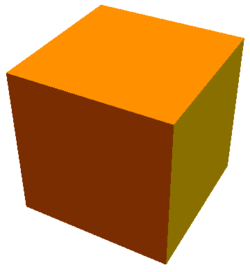Cutting a Menger Sponge
I feel a bit like a mindless hack using this material from Alex Bellos's column, but the result is so pretty that I wanted to share it. So to set my mind at rest, here's a plug for his work. Bellos compiles a puzzle for the readers of the guardian once a fortnight and they are fantastic (although often quite difficult). You can check it out here.
A Menger Sponge is a 3D fractal formed by starting with a cube which you could split into 27 small cubelets a bit like a Rubik's Cube. Then you remove the central cubelet from each face as well as the very central one. This process is repeated on each remaining cube until you get something infinitely detailed. Below is a GIF of the first 4 iterations which I nabbed from Wikipedia:
If you take a normal cube then you can cut it into 2 equal pieces like the picture below. Notice that the cross section is a regular hexagon.
Bellos's question from the column this week is: what does the the equivalent cross section look like for the Menger Sponge?
I got nowhere near the remarkable answer but I did manage to convince myself that the hexagon would indeed have 6 unbroken edges as its perimeter. To show that you have to check that the line drawn from the centre of one of the edges of a cube to another avoids all the squares that will pop up on that face. This is not easy, but you can get there with a bit of induction work and geometric series manipulation.
You should be able to convince yourself the cross section will definitely have a hole in the centre of it, but what shape is that hole? A hexagon seems likely, but here's the real answer:
The cross section of a cube which has gone 3 iterations.
That 6 pointed stars come out of this is deeply surprising. Here's a 3D projection that someone submitted to Bellos:
Beautiful.










